When wildlife become a nuisance in your yard, there are several approaches you can take (see https://edis.ifas.ufl.edu/collections/series_managing_nuisance_wildlife_in_your_yard). You can make habitat modifications, use deterrents, or trap animals. In most residential settings, making habitat modifications or using deterrents will be both simpler and more effective than trapping. See EDIS publications WEC325, "How to modify habitat to discourage nuisance wildlife in your yard," and WEC326, "How to use deterrents to stop damage caused by nuisance wildlife in your yard," for more information on these approaches. However, trapping is warranted in certain situations when trying to solve conflicts between people and wildlife.
This document provides information on stopping wildlife damage through the use of trapping. We describe several of the trap types most commonly used to capture wildlife; list the species you are likely to catch with each trap type; provide guidance on where to set each trap; make suggestions on what materials to use to bait traps; provide instructions on how to set traps; describe safety issues associated with setting traps and safety issues caused by dangerous animals you may catch; provide suggestions on how to handle captured animals and what to do with them after capture; and, finally, describe legal regulations regarding trapping and relocation.
When Is Trapping Warranted?
Before you begin to trap animals, it is important to realize that trapping is often only a temporary solution to nuisance wildlife problems. Trapping is far more effective when animals need to be removed from a building than when they are causing a problem in an outdoor setting. If the habitat quality in your yard is high and the abundance of wildlife in the area is high, it will not take long for new individuals to move in once you have trapped the original out.
It is also important to realize that trapping requires patience, persistence, and knowledge of the habits of the animal you are trying to capture. Trapping is not a quick fix to nuisance wildlife problems.
Before you begin trapping, be sure you have a suitable plan for what you will do with the trapped animal. Regulations regarding the release of wild animals from traps are strict, so wait to set your live traps until you have a workable plan for how and where you will release any animals you trap. If you have a situation that warrants the use of kill traps, be sure you have a plan for dealing with the animals your traps will collect.
Finally, carefully follow all directions on trap labels. We present general guidelines that should not supersede actual instructions provided with purchased traps. Never place traps in areas where unsupervised children and pets may trigger them. Always follow state and federal regulations regarding wildlife.
Live Traps
Wire Cage Traps
Wire cage traps, frequently sold under brand names such as Tomahawk or Havahart, are available in various sizes, making them appropriate for catching a wide variety of wildlife species. These wire mesh traps allow you to safely and easily release trapped animals elsewhere (Figure 1). Trap sizes range from those suitable for small rodents (16 inches by 5 inches by 5.5 inches) to those suitable for large dogs (72 inches by 20 inches by 26 inches). Most reputable retailers describe which wildlife species are most likely to be caught in each of the trap sizes they offer. The size of a trap is a more important consideration than its brand. Medium-sized traps are appropriate for many of the mid-sized mammals that regularly cause problems in residential settings, such as opossums (Didelphis virginiana), raccoons (Procyon lotor), skunks (Mephitis spp.), feral cats, armadillos (Dasypus novemcinctus), or rabbits (Sylvilagus floridanus).
Several variations of these traps are available. Many retailers sell wire cage traps in both a collapsible form (which is helpful if your storage space is limited) or rigid form (which is more durable, and therefore recommended if you expect to need to use traps regularly).
Traps are also available with one door or two. Traps with two doors tend to be heavier and more expensive, but make releasing animals much easier, because animals do not have to back out the same door through which they entered the trap. Two-door traps also increase the chances of an animal finding the opening of the trap since there are two openings rather than just one. However, traps with only one door may have higher capture success because animals are forced to move all the way to the back of the trap to get the bait, ensuring that the door will close completely when triggered, which may not be the case with two-door traps where bait is placed in the middle.
Always place the bait for a wire cage trap on or behind the trigger mechanism so that animals are encouraged to step all the way inside the cage. When using traps with one door, consider screening the back portion of the trap where the bait is placed to prevent animals from reaching through the side of the trap to pull out the bait. Also, some species may be further encouraged to enter traps if soil or leaves are placed on the floor of the trap to cover the metal mesh. Always place traps as level as possible to reduce the chances of a captured animal later rolling the trap over when trying to escape.
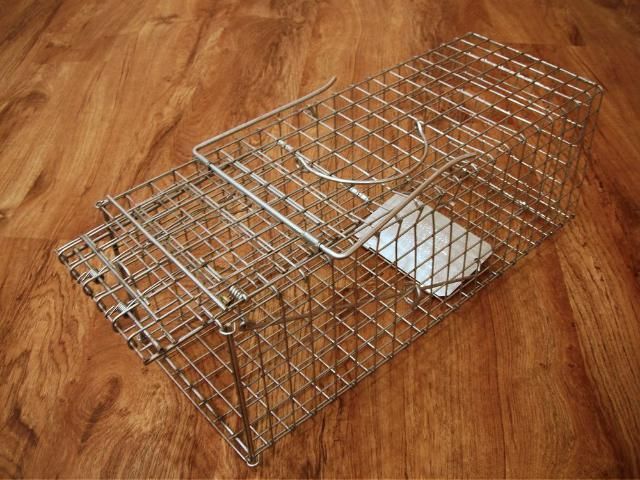
Credit: Holly Ober, UF/IFAS
Sherman Traps
Sherman traps are also available in several sizes, all of which are meant for small mammals such as rats (Rattus spp.), mice, voles (Microtus pinetorum), shrews (Blarina carolinensis), chipmunks (Tamias striatus), and gray squirrels (Sciurus carolinensis) (Figure 2). The largest size is 3 inches by 3.75 inches by 12 inches, and the smallest size is 2 inches by 2.5 inches by 6.5 inches. It is again fairly easy to release animals from this type of trap.
Sherman traps are available in folding and non-folding forms. They are manufactured from aluminum (your choice of three thicknesses) or steel (your choice of two gauges). They are sold with solid or perforated walls and doors; in case you are concerned about the temperatures or dampness experienced by the animal inside.
Sherman traps should always be baited to entice animals to enter. Baiting the trap for several days with the door forced to remain open may encourage animals to feel comfortable fully entering the trap before you set the trap for real. The door can be held open with Popsicle sticks or tongue depressors.
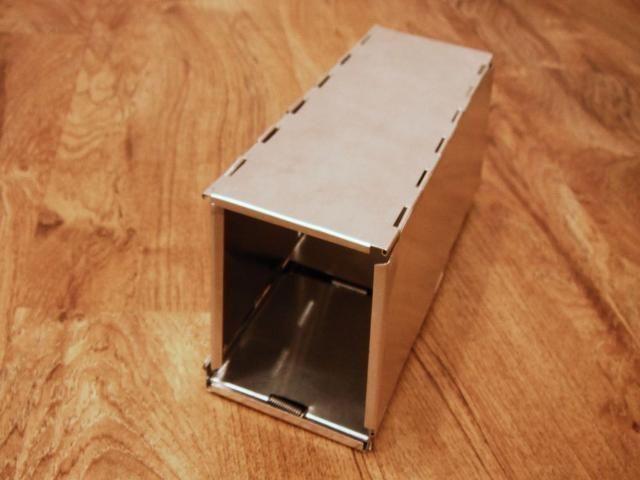
Credit: Holly Ober, UF/IFAS
Glueboards
Glueboards are appropriate for snakes and small rodents such as rats or mice. Manufacturers typically market different boards for different wildlife species (Figure 3). For example, boards can be purchased pre-scented with peanut butter smell to entice rats and mice.
Once an animal has moved onto the board and become stuck, the entire board can be moved to the location where the animal is to be set free, and cooking oil can be poured on the animal to release it from the glue. Vegetable oil will not harm the trapped animal.
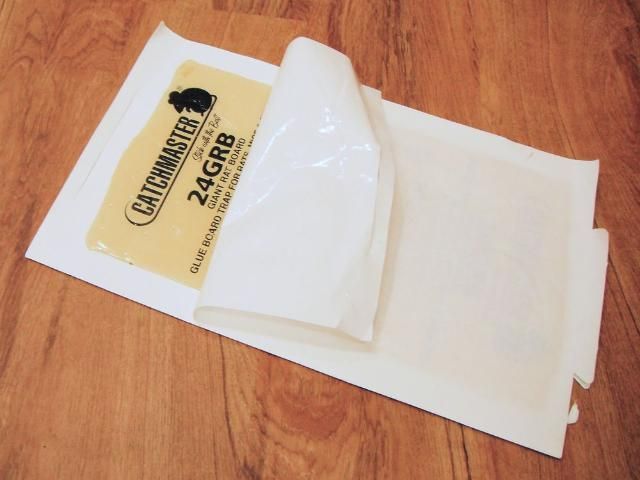
Credit: Holly Ober, UF/IFAS
Steel Leg-Hold Traps
Steel leg-hold traps can be used only by permit from the Florida Fish and Wildlife Conservation Commission (Figure 4). The Commission only issues the permit to landowners experiencing problems with coyotes, bobcats, foxes, beavers, and otters. These traps must be checked at least every 24 hours by law.
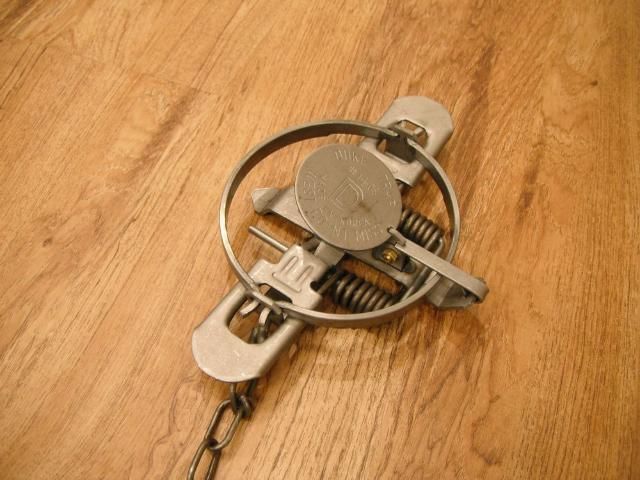
Credit: Holly Ober, UF/IFAS
Kill Traps
Snap Traps
Snap traps are useful for capturing mice, rats, and voles (Figure 5). Some varieties allow the user to alter the sensitivity of the trap. These traps can be baited or left unbaited. They are lethal to the animal captured.
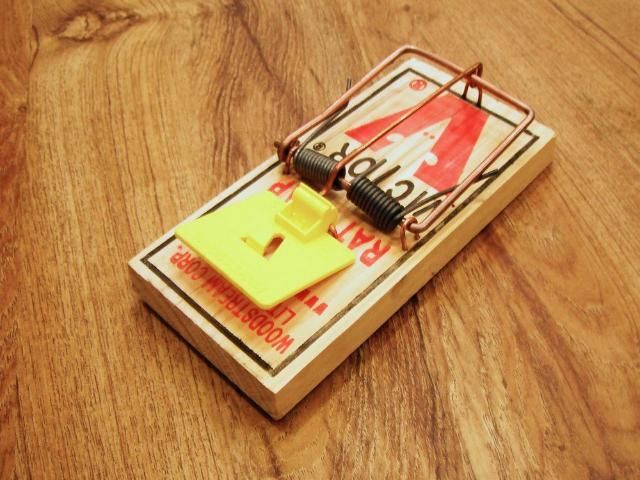
Credit: Holly Ober, UF/IFAS
Scissor Traps
Scissor traps can be used for capturing moles (Scalopus aquaticus) (Figure 6). The trap must be placed above a mole tunnel. The lower half of the trap should be underground, while the upper half sits above the surface of the lawn. These traps are often sold with a special pair of tongs useful for setting and handling the traps. Scissor traps should not be baited. These traps are lethal.

Credit: Holly Ober, UF/IFAS
Harpoon Traps
Harpoon traps are also useful for catching moles (Figure 7). The trap should be positioned with the metal legs of the trap straddling a mole tunnel. These traps typically have six sharply sheared points. When set, the spears are retracted into the roof of the tunnel, allowing the mole to pass underneath. The trap must be set so that when triggered, the points are propelled through the mole's tunnel. If you step on the tunnel so that it is partially collapsed, a mole will later trigger the trap when it pushes dirt upward against the triggering plate to repair the tunnel, causing the springs to release the spears into the tunnel. Harpoon traps should not be baited. These traps are lethal.
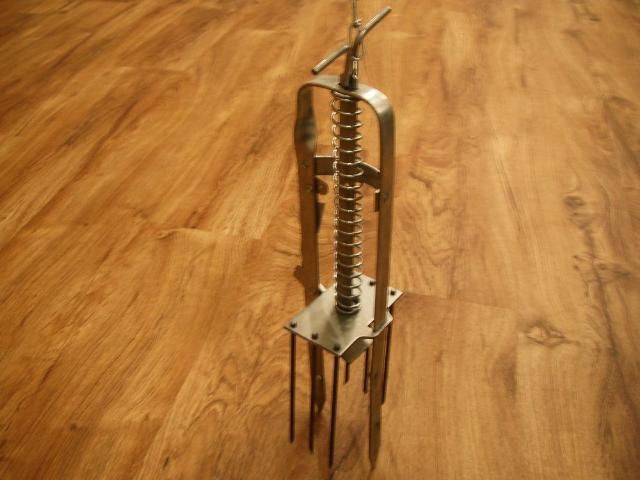
Credit: Holly Ober, UF/IFAS
Choker Loop Traps
Choker loop traps are also effective for moles (Figure 8). As described with the harpoon trap, the choker loop trap should be set across a tunnel that you partially collapse. The choker loops should be inserted into narrow slots you form across the tunnel, and the trigger should be placed in the collapsed section of the tunnel. The animal will then be squeezed between the loop and the body of the trap when it is triggered. These traps are lethal.
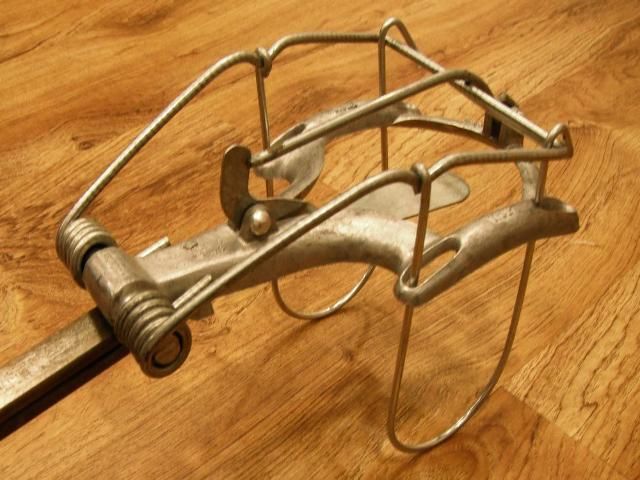
Credit: Holly Ober, UF/IFAS
Pincher Traps
Pincher traps are the best trap type for catching pocket gophers (Figure 9). These traps are often called Macabee traps or cinch traps. These traps have two prongs that snap closed when an animal pushes against a vertical plate (the treadle). These traps are most effective when two traps are set facing opposite directions in a gopher tunnel to enable capture of animals advancing from either direction. Pincher traps are lethal.
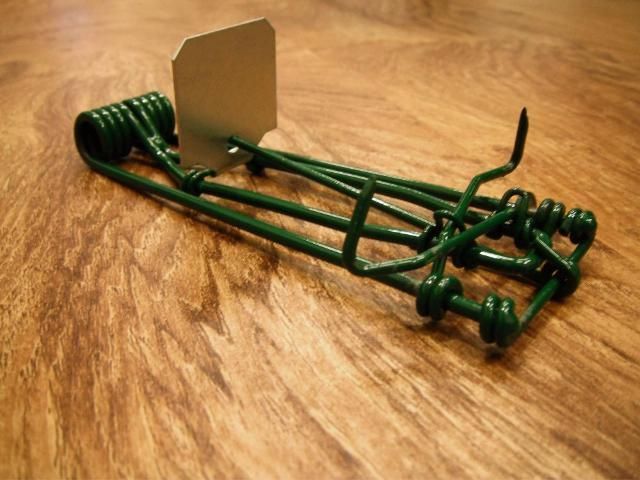
Credit: Holly Ober, UF/IFAS
Conibear Traps
Conibear traps are useful for capturing beaver (Castor canadensis). The trap consists of a heavy steel square with two springs in the shape of a "V." When set, the tops of the "V" are pressed together (Figure 10). There is a safety latch on each "V" so that each can be latched in place once they are compressed. After both "V"'s are compressed, a key is inserted into the groove of the trigger and the trap placed in position. When ready, the safety latches are released. A great deal of strength is required to compress the "V" springs, so it is strongly recommended that you purchase "setters" to compress the springs with a lot of leverage.
The Florida Fish and Wildlife Conservation Commission allows these traps to be used only underwater (non-target species could be killed if they were set on land). Use of these traps in Florida is illegal without a permit. These traps are lethal.
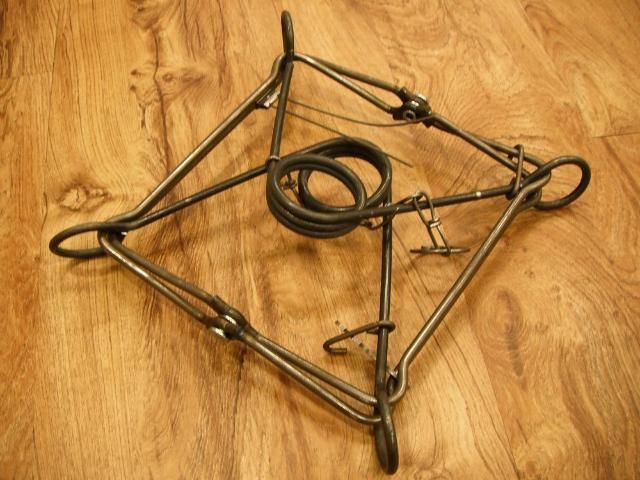
Credit: Holly Ober, UF/IFAS
Baiting Traps
As indicated above, some traps are meant to be left unbaited, whereas others will never successfully capture an animal without bait. Many household food items like peanut butter, nuts and seeds, cat food, and sardines are attractive to a variety of wildlife species. Baiting traps with these items that many different species like could prove problematic if you are in an area with a variety of wildlife species and you only want to catch a single species. Baits and lures sold commercially provide a safer alternative. These are often more species-specific, which can help prevent capture of non-target species. Finally, non-meat baits tend to spoil less quickly in hot weather and may be less attractive to pets. See Table 1 for suggestions on the most appropriate bait materials for common nuisance wildlife species.
Toxic baits (i.e., anti-coagulants, or slow-acting toxicants) are legal only for the control of non-native rats and house mice. These baits must, by law, be presented in bait boxes that prevent access by other types of wildlife, pets, livestock, or children. Also, these bait stations should be placed along known travel paths of these animals, rather than out in the open where they are more accessible to unintended target species or children.
Placing Traps
Selecting the proper location is a key element to effective trapping. Traps should be placed in areas nuisance wildlife are known to be using. Good examples include near burrows or travel paths. Traps should be faced into burrow openings to catch animals as they emerge. Traps with two doors work well when set along a wall, fence, or other barrier that encourages movement in a straight line, so that animals can be captured while traveling either direction.
Timing should also be considered carefully. Set the trap only during the time of day the target species is most active to limit your chances of catching non-target species. Check each trap at least once a day if not more often so that animals do not suffer unnecessarily. When possible, set traps beneath vegetation so that captured animals have protection from the sun and rain.
Relocating Wildlife
Relocating wildlife is discouraged for a number of reasons. First, new individuals from the same species are likely to move into the area the original animal was trapped from if the same resources still exist there. Thus, trapping often does not solve the real nuisance wildlife problem in the location from which the animal was trapped. Second, translocated animals often have difficulty finding food and shelter in the area they have been moved to, either because food and shelter do not exist in the new habitat or because other individuals have already established territories in the region. Third, translocated animals may become a nuisance in the areas where they are released. Fourth, human-assisted movement of animals may further the spread of wildlife diseases to new locations.
According to Florida law, trapped wildlife can only be released on the same property on which it was caught or on property of at least 40 acres in size within the county of capture where you have obtained written landowner permission. Certain species, such as raccoons, can never be transported and released because of the high potential of the species to harbor rabies. Raccoons may be legally transported outside of city limits only for the purpose of euthanasia.
If an animal will be relocated, the trap should be covered with a cloth to reduce stress on the animal and transported quickly to the release location. Move animals far enough away that they will not return to their original home range (this minimum required distance varies among species). Wear gloves during the release in order to prevent bites and limit the spread of disease.
Additional Sources of Information
Kern, W. H., Jr. 1991. Northern Raccoon. WEC34. Gainesville: University of Florida Institute of Food and Agricultural Sciences. Available at https://edis.ifas.ufl.edu/uw033
Kern, W. H., Jr. 1991. Rat and Mouse Control. ENY224. Gainesville: University of Florida Institute of Food and Agricultural Sciences. Available at https://edis.ifas.ufl.edu/dh044
Kern, W. H., Jr. 1997. Control of Roof Rats in Fruit Trees. SSWEC120. Gainesville: University of Florida Institute of Food and Agricultural Sciences. Available at https://edis.ifas.ufl.edu/uw120
Ober, H. K. and A. Kane. 2012. Overview of How to Stop Damage Caused by Nuisance Wildlife in Your Yard. WEC323. Gainesville: University of Florida Institute of Food and Agricultural Sciences. Available at https://edis.ifas.ufl.edu/uw368
Ober, H. K. and A. Kane. 2012. How to Identify the Wildlife Species Responsible for Damage in Your Yard. WEC324. Gainesville: University of Florida Institute of Food and Agricultural Sciences. Available at https://edis.ifas.ufl.edu/uw369
Ober, H. K. and A. Kane. 2012. How to Modify Habitat to Discourage Nuisance Wildlife in Your Yard. WEC325. Gainesville: University of Florida Institute of Food and Agricultural Sciences. Available at https://edis.ifas.ufl.edu/uw370
Ober, H. K. and A. Kane. 2012. How to Use Deterrents to Stop Damage Caused by Nuisance Wildlife in Your Yard. WEC326. Gainesville: University of Florida Institute of Food and Agricultural Sciences. Available at https://edis.ifas.ufl.edu/uw371
Schaefer, J. 1990. Dealing with Unwanted Wildlife in an Urban Environment. WEC20. Gainesville: University of Florida Institute of Food and Agricultural Sciences. Available at https://edis.ifas.ufl.edu/uw070
Table 1. Recommended trap types and bait materials for catching nuisance wildlife in Florida.